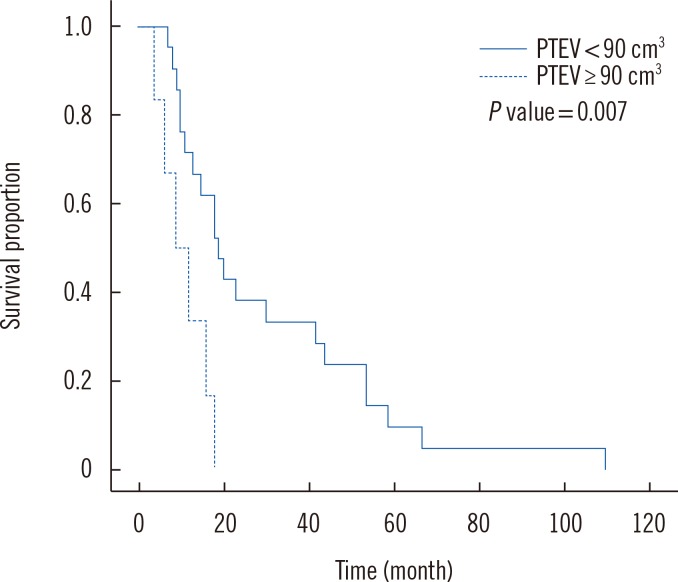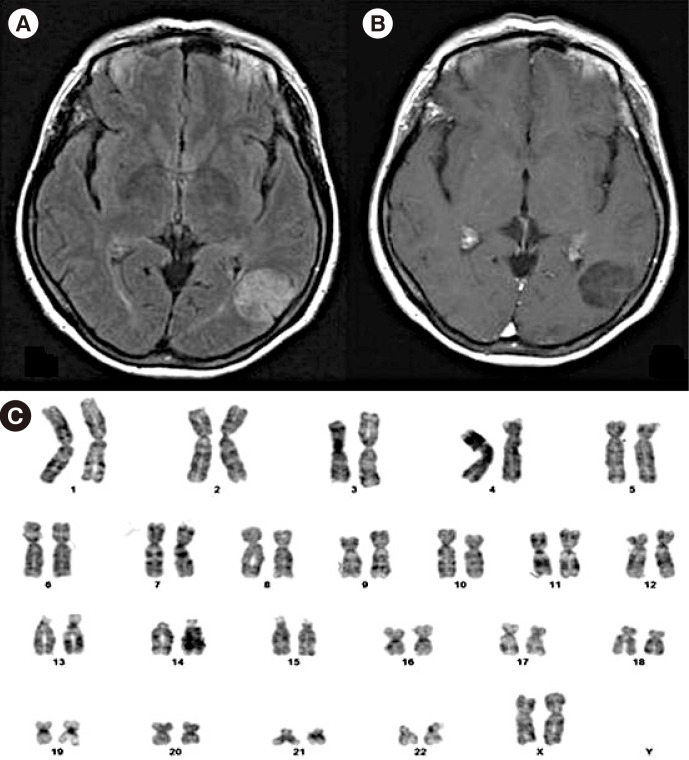Ann Lab Med.
2016 Nov;36(6):583-589. 10.3343/alm.2016.36.6.583.
Relationship Between Cytogenetic Complexity and Peritumoral Edema in High-Grade Astrocytoma
- Affiliations
-
- 1Department of Neurosurgery, Medical Science Research Center, College of Medicine, Dong-A University, Busan, Korea. kukim@donga.ac.kr
- 2Brain Tumor Institute, Medical Science Research Center, College of Medicine, Dong-A University, Busan, Korea.
- 3Department of Laboratory Medicine, College of Medicine, Dong-A University, Busan, Korea.
- KMID: 2373597
- DOI: http://doi.org/10.3343/alm.2016.36.6.583
Abstract
- BACKGROUND
The purpose of the study is to reveal the association of cytogenetic compltyexi and peritumoral edema volume (PTEV) and its prognostic significance in high-grade astrocytoma patients by culturing patient tumor cells.
METHODS
Twenty-seven high-grade astrocytoma patients were divided into three groups according to karyotype complexity: normal, non-complex karyotype (NCK), and complex karyotype (CK). Endothelial growth factor receptor (EGFR) amplification was detected by FISH, and its association with chromosome 7 abnormalities was analyzed. Mean PTEV of each group was compared by ANOVA to evaluate the relationship between PTEV and cytogenetic complexity.
RESULTS
The PTEV of patients in normal (n=6), NCK (n=8), and CK (n=13) groups were 24.52±17.73, 34.26±35.04, and 86.31±48.7 cm3, respectively (P=0.005). Ten out of 11 patients with EGFR amplification showed abnormalities in chromosome 7. The mean PTEV of EGFR-amplified and non-amplified groups were 80.4±53.7 and 41.3±37.9 cm3, respectively (P=0.035). The average survival of patients with PTEV less than 90 cm3 was 30.52±26.11 months, while in patients with PTEVs over or equal to 90 cm3, it was 10.83±5.53 months (P=0.007).
CONCLUSIONS
The results show an association of complex karyotype with the PTEV of high-grade astrocytoma. EGFR amplification plays a significant role in the formation of peritumoral edema, causing PTEV to increase, which is related with survival. This implies that cytogenetic karyotype can be applied as a prognostic factor.
MeSH Terms
-
Adult
Aged
Astrocytoma/diagnostic imaging/mortality/*pathology
Brain Neoplasms/diagnostic imaging/mortality/*pathology
Chromosome Aberrations
Chromosomes, Human, Pair 7
Edema/diagnostic imaging/pathology
Female
Humans
In Situ Hybridization, Fluorescence
Kaplan-Meier Estimate
Karyotype
Magnetic Resonance Imaging
Male
Middle Aged
Neoplasm Grading
Prognosis
Receptors, Vascular Endothelial Growth Factor/metabolism
Tumor Cells, Cultured
Young Adult
Receptors, Vascular Endothelial Growth Factor
Figure
Reference
-
1. Ohgaki H, Kleihues P. Population-based studies on incidence, survival rates, and genetic alterations in astrocytic and oligodendroglial gliomas. J Neuropathol Exp Neurol. 2005; 64:479–489. PMID: 15977639.2. Heimberger AB, Hlatky R, Suki D, Yang D, Weinberg J, Gilbert M, et al. Prognostic effect of epidermal growth factor receptor and EGFRvIII in glioblastoma multiforme patients. Clin Cancer Res. 2005; 11:1462–1466. PMID: 15746047.3. Stupp R, Mason WP, van den Bent MJ, Weller M, Fisher B, Taphoorn MJ, et al. Radiotherapy plus concomitant and adjuvant temozolomide for glioblastoma. N Engl J Med. 2005; 352:987–996. PMID: 15758009.4. Walid MS. Prognostic factors for long-term survival after glioblastoma. Perm J. 2008; 12:45–48. PMID: 21339920.5. Barker FG 2nd, Simmons ML, Chang SM, Prados MD, Larson DA, Sneed PK, et al. EGFR overexpression and radiation response in glioblastoma multiforme. Int J Radiat Oncol Biol Phys. 2001; 51:410–418. PMID: 11567815.6. Lu-Emerson C, Duda DG, Emblem KE, Taylor JW, Gerstner ER, Loeffler JS, et al. Lessons from anti-vascular endothelial growth factor and anti-vascular endothelial growth factor receptor trials in patients with glioblastoma. J Clin Oncol. 2015; 33:1197–1213. PMID: 25713439.7. Das P, Puri T, Jha P, Pathak P, Joshi N, Suri V, et al. A clinicopathological and molecular analysis of glioblastoma multiforme with long-term survival. J Clin Neurosci. 2011; 18:66–70. PMID: 20888234.8. Gan HK, Kaye AH, Luwor RB. The EGFRvIII variant in glioblastoma multiforme. J Clin Neurosci. 2009; 16:748–754. PMID: 19324552.9. Hartmann C, Hentschel B, Simon M, Westphal M, Schackert G, Tonn JC, et al. German Glioma Network. Long-term survival in primary glioblastoma with versus without isocitrate dehydrogenase mutations. Clin Cancer Res. 2013; 19:5146–5157. PMID: 23918605.10. Hur H, Jung S, Jung TY, Kim IY. Cerebellar glioblastoma multiforme in an adult. J Korean Neurosurg Soc. 2008; 43:194–197. PMID: 19096643.11. Jain R, Poisson L, Narang J, Gutman D, Scarpace L, Hwang SN, et al. Genomic mapping and survival prediction in glioblastoma: molecular subclassification strengthened by hemodynamic imaging biomarkers. Radiology. 2013; 267:212–220. PMID: 23238158.12. Montgomery RM, Queiroz Lde S, Rogerio F. EGFR, p53, IDH-1 and MDM2 immunohistochemical analysis in glioblastoma: therapeutic and prognostic correlation. Arq Neuropsiquiatr. 2015; 73:561–568. PMID: 26200049.13. Shiraishi S, Tada K, Nakamura H, Makino K, Kochi M, Saya H, et al. Influence of p53 mutations on prognosis of patients with glioblastoma. Cancer. 2002; 95:249–257. PMID: 12124823.14. Lopez-Gines C, Cerda-Nicolas M, Gil-Benso R, Pellin A, Lopez-Guerrero JA, Callaghan R, et al. Association of chromosome 7, chromosome 10 and EGFR gene amplification in glioblastoma multiforme. Clin Neuropathol. 2005; 24:209–218. PMID: 16167544.15. Reardon D, Wen P, Mellinghoff IK. Targeted molecular therapies against epidermal growth factor receptor: past experiences and challenges. Neuro Oncol. 2014; 16(S8):viii7–viii13. PMID: 25342602.16. Lal A, Glazer CA, Martinson HM, Friedman HS, Archer GE, Sampson JH, et al. Mutant epidermal growth factor receptor up-regulates molecular effectors of tumor invasion. Cancer Res. 2002; 62:3335–3339. PMID: 12067969.17. Schoenegger K, Oberndorfer S, Wuschitz B, Struhal W, Hainfellner J, Prayer D, et al. Peritumoral edema on MRI at initial diagnosis: an independent prognostic factor for glioblastoma? Eur J Neurol. 2009; 16:874–878. PMID: 19473360.18. Smith JS, Tachibana I, Passe SM, Huntley BK, Borell TJ, Iturria N, et al. PTEN mutation, EGFR amplification, and outcome in patients with anaplastic astrocytoma and glioblastoma multiforme. J Natl Cancer Inst. 2001; 93:1246–1256. PMID: 11504770.19. Krex D, Klink B, Hartmann C, von Deimling A, Pietsch T, Simon M, et al. German Glioma Network. Long-term survival with glioblastoma multiforme. Brain. 2007; 130:2596–2606. PMID: 17785346.20. Lawrence YR, Mishra MV, Werner-Wasik M, Andrews DW, Showalter TN, Glass J, et al. Improving prognosis of glioblastoma in the 21st century: who has benefited most? Cancer. 2012; 118:4228–4234. PMID: 22180310.21. Schmidt MC, Antweiler S, Urban N, Mueller W, Kuklik A, Meyer-Puttlitz B, et al. Impact of genotype and morphology on the prognosis of glioblastoma. J Neuropathol Exp Neurol. 2002; 61:321–328. PMID: 11939587.22. Aghi M, Gaviani P, Henson JW, Batchelor TT, Louis DN, Barker FG 2nd. Magnetic resonance imaging characteristics predict epidermal growth factor receptor amplification status in glioblastoma. Clin Cancer Res. 2005; 11:8600–8605. PMID: 16361543.23. Maire CL, Ligon KL. Molecular pathologic diagnosis of epidermal growth factor receptor. Neuro Oncol. 2014; 16(S8):viii1–viii6. PMID: 25342599.24. Maity A, Pore N, Lee J, Solomon D, O'Rourke DM. Epidermal growth factor receptor transcriptionally up-regulates vascular endothelial growth factor expression in human glioblastoma cells via a pathway involving phosphatidylinositol 3'-kinase and distinct from that induced by hypoxia. Cancer Res. 2000; 60:5879–5886. PMID: 11059786.
- Full Text Links
- Actions
-
Cited
- CITED
-
- Close
- Share
- Similar articles
-
- Pleomorphic Xanthoastrocytoma with Peritumoral Edema: A Case Report
- Radiological Characteristics of Peritumoral Edema in Meningiomas
- Permeability Changes of Capillary Endothelial Monolayer according to the Malignancy of Co-cultured Cell Lines
- Value of Perfusion Weighted Magnetic Resonance Imaging in the Diagnosis of Supratentorial Anaplastic Astrocytoma
- Correlation Between the Expression of Epidermal Growth Factor Receptor and MR Features in Glioma




